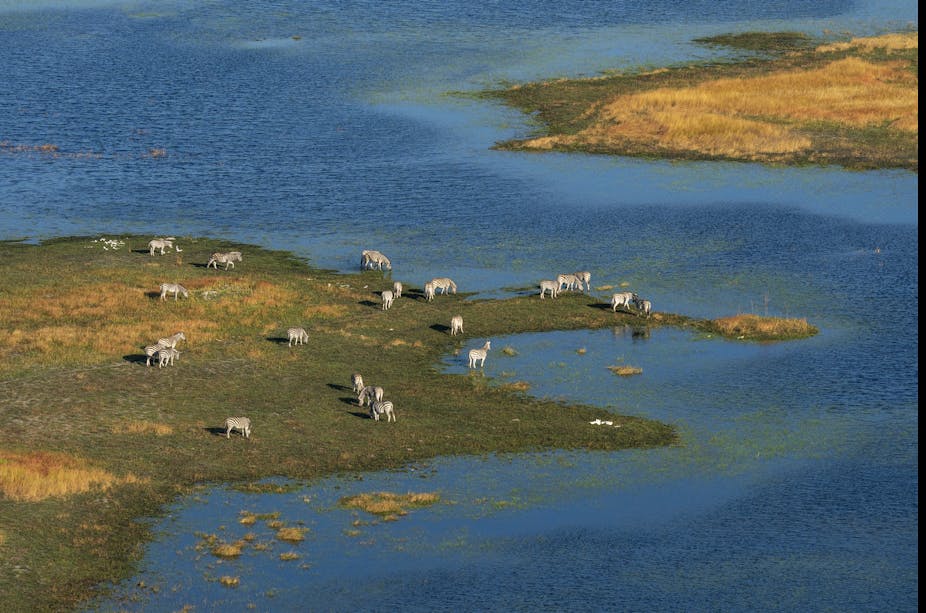The Namibian and Botswana governments may be risking their water resources for oil and gas revenue. They have licensed a Canadian firm, ReconAfrica, to prospect for oil in the Cubango Okavango River Basin, in an area covering 34,000km².
In total, the river basin covers 700,000km², encompassing a network of river systems across Angola, Namibia and Botswana. The Cubango and Cuito rivers, which originate from the Angolan highlands, join the Okavango River at the border between Angola and Namibia, and flow into the Okavango Delta in Botswana.
The Okavango River sustains over half a million people in Namibia and Botswana. The main livelihood activities in the basin are arable farming, livestock farming, fishing and tourism.
The Okavango Delta, a World Heritage Site, contributes significantly to tourism in Botswana. It is one of the largest freshwater wetlands in southern Africa and home to over 1,000 plant species. Over 480 bird species, 130 species of mammals, and numerous species of reptiles and fish can be found in the area.
Our team, with expertise in groundwater resource assessment and protection, has assessed the vulnerability of the Okavango River and Delta to oil and gas drilling. We conclude that possible impacts on water resources are of particular concern in this sensitive area.
Reasons to worry
It is worrying that oil and gas extraction is being considered in this area. The current exploration licence in Namibia allows the company to drill exploratory stratigraphic wells. Drilling near the Omatako River in Namibia already endangers the groundwater since the drilling waste fluids have been discarded in unlined pits. Most people in this arid region rely on groundwater, which can easily be contaminated when the water table is shallow, as it is here.
ReconAfrica estimates that the area has large volumes of oil and gas resources, though it has not yet fully assessed whether recovering them would be economical. The resources are in a site about the size of the Eagle Ford shale field in Texas, a very large oil and gas deposit.
Several geologists have noted, however, that the resources are unlikely, in their view, to be economically viable, based on the geological information of the region.
Meanwhile, the Namibian government granted Recon exploration licences without following due procedure for its environmental impact assessment. This is despite the fact that the lease area includes parts of the Kavango Zambezi Transfrontier Park and the Okavango River.

What we found
Our study illustrates the possible grim impact of the potential oil and gas extraction operations. This includes possible contamination of:
the water resources around the Omatako River
the Okavango River
the Okavango Delta.
We used publicly accessible borehole data from the Namibian Ministry of Agriculture, Water and Land Reform, and the Botswana Department of Water Utilities. We obtained geological structure data from Namibia’s Geological Survey and the Botswana Geoscience Information Centre.
We found that contamination could infiltrate the aquifer system and contaminate the groundwater near the Omatako River. Contaminated groundwater could take three to 23.5 years to reach the Okavango River system via the shallow, sandy aquifer.
Contaminated groundwater from proposed drill sites could reach the Okavango Delta even faster along another route: certain geological structures underground. These structures – grabens and dykes – have associated faulting and fractures respectively, along which groundwater can travel.
The geological structures in the area are associated with parts of the Earth’s crust that are tectonically active: they might change. This makes it more complicated to assess the Okavango Delta’s vulnerability. Existing permeable structures can serve as pathways for groundwater contamination. Tectonic stresses can create new permeable structures or modify ones that were previously impermeable.
Initial calculations, using publicly accessible data, indicate that contamination from drilling activities that travels via geological structures could reach the Okavango Delta within just four days.

Our results should be verified with localised field studies.
Need to revisit clearance certificate
A ReconAfrica environmental impact assessment did not identify any serious risks that could follow from oil drilling in the area. The Namibian government then awarded an updated environmental clearance certificate to the company.
Even though there wasn’t enough data to determine the possible groundwater impact, the environmental impact assessment deemed contamination to be negligible.
Our study highlights the possible dire consequences of allowing oil and gas extraction activities in the Cubango Okavango River Basin.
Based on our results, we recommend that all oil and gas extraction activities in the Okavango region be halted until there’s a proper understanding of the groundwater sources, pathways and receptors.
Future environmental impact assessments must make an honest effort to obtain all relevant information so that all possible risks to water resources are identified. This would allow for the proper protection of natural resources.

